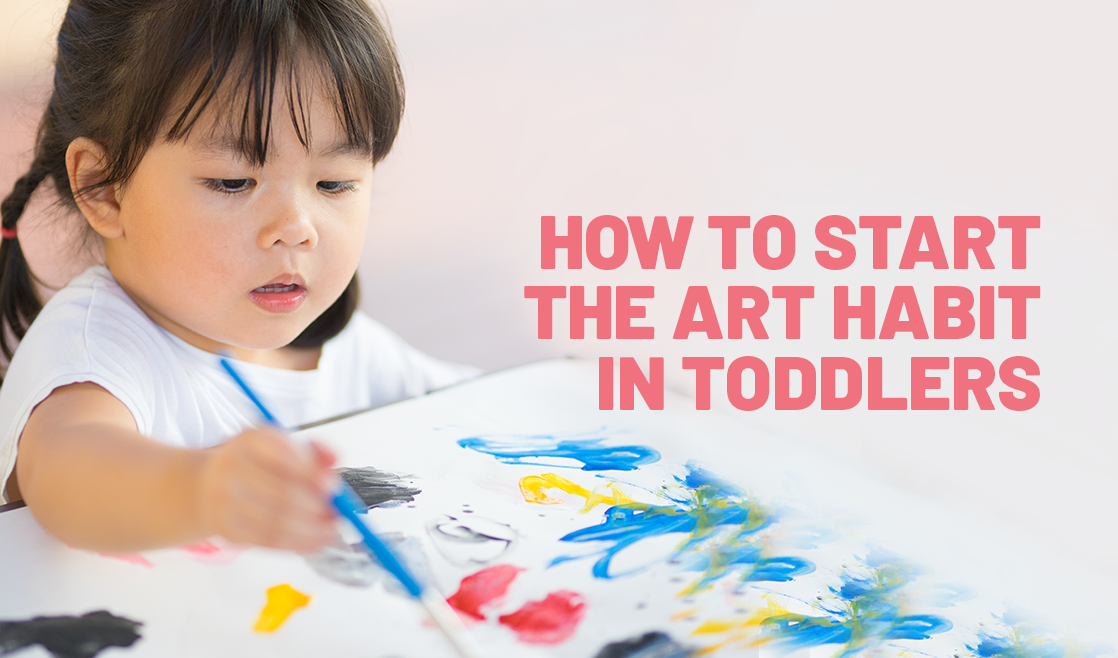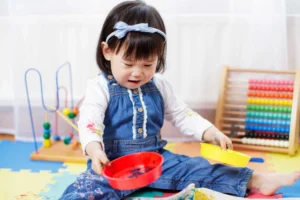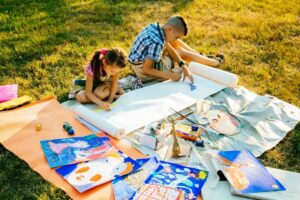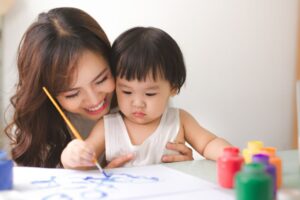How To Start The Art Habit In Toddlers
![]()
- Posted by abrakadoodle.com.sg
- Categories Kids Art Activities
- Date 15 April 2021

Children have the natural ability to make connections between unrelated things, Make ideas and imagine new ways to express their thoughts and communicate. Hence, anything that can stimulate and engage their creative minds is good for them. Especially so, when you are planning on making
art into a habit.
Toddler art activities gives children a vital creative outlet to express and make sense of their emotions, in particular when they might not always have the words to describe what they’re feeling. This is why setting up life-long habits of taking part in making art provides toddlers and young children with invaluable experiences. You can help them cope with life’s challenges.
You owe it to your child to ensure that she experience sand adopts arts enriching habits as early as possible. It will contribute to all aspects of her development, as well as equip her to be more resilient throughout her life.
Table of Contents
ToggleGiving toddlers a boost
Toddlers are high on energy and have shorter attention spans. They get bored quickly when they discover they are not acquiring any new skills. Having art and craft workshop at home helps flex the imagination in toddlers and adults alike. This is perhaps one of the many reasons why we’ve been making art since the time we were living in caves.Toddler art activities create opportunities to explore and express emotions through imaginative play with art. It supports good mental health and promotes well being.
Remember, when children are involved in making art, they’re also making a series of decisions — whether to use a pencil or a big fat crayon or washable colours; what colour to choose; and how to put on paper what they’re seeing in their minds. Interpreting these images and figuring out what these pictures mean.
Once into toddler art activities, you will begin to notice your child is experimenting and thinking creatively and learning new things and how excited she gets by seeing what she can do in such a short time.
Toddler art activities
According to some studies, our brain is a predictive machine. It uses information to make predictions about what we might do next — and more importantly what we need to do next to understand the world around us and thrive in it.Art and craft activities for pre-schoolers and toddlers fall under process art – a way of encouraging exploration and experimentation with new materials and methods. These are open-ended art activities that toddlers don’t get bored with and can try over and over again!
Living in the moment
Toddlers and young children live in the moment — they love the way it feels when they play with colours. Sprinkling glitter will make any art sparkle. Share the growing excitement, of watching colours dissolve into different shades as they spread across a wet paper.Toddlers are not self-conscious about what they’re doing or focused on creating a desired outcome. They just let go, this is natural and already a habit with them. All you are doing is reinforcing it through art and play.
It is best to let your child be, she will enjoy the process of creation. Expressing in the moment and expressing herself will give your child the ability to believe in herself. It is what growing up smarter is all about!
But why art of all things?
Art is not just colour, paint brush, paper or a canvass, it is all the things you can do to stimulate the imagination of your toddler. Remember, art is a process, a journey that helps creativity take wings.Art and craft activities for preschoolers nurtures the imagination. Which means sparking and increasing creativity in your child. Enabling a free-thinking sort of mind that is not afraid to think or imagine differently.
As da Vinci would have advised parents and their healthy and happy toddlers, Art and craft activities for preschoolers helps them develop mentally, socially, and emotionally. Creating art also helps your child to learn and acquire the skill to analyze and problem-solve. But that is not the end.
As your toddler learns to handle and play with a paintbrush or the big, fat crayon, her fine motor skills are being exercised. By counting pieces and colours, she would learn the basics of math. When she begins to experiment with materials, she will dabble in science.
The most important trait of all however, is when she feels good while creating. Your child’s self-confidence gets a big boost. Art is real thinking in its purest form and expressing these original ideas will soon become a habit.
Besides, your little one will also learn early in her life that it is OK to make mistakes. At her age, you will find that art is perhaps the only way to make her feel free to experiment and to make mistakes. Feeling the freedom. Feeling free to invent new ways of looking, thinking, doing and being.
Inspire creativity
- 1. A place you can mess with. This is your art space where both of you are free to experiment and get messy in the process. Lay a mat on the kitchen top or use old newspaper. If weather permits, take your toddler outside to paint. Garage or your parking space in the cellar will do.
2. Don’t direct, flow Become one with your child. See her world. It will make a big difference to the way you look at the world. You won’t tell her to paint a rainbow, instead you will encourage her to experiment with mixing colours. It is great fun in itself.
3. Share stories of great masters. Their lives, what they are famous for, even their quirky habits. The Net is full of little known facts of great masters and their lives. After all, masters too are like us, human.
4. If you like to comment on your toddler’s work, avoid saying, “looks great.” This is a non-starter. Instead say, “Wow, it is all so purple. Can you tell me why?” She will open her mind to you.
5.Understanding the process. Discovering process art brings clarity to thought, encourages you to share thoughts and feelings about things. Dive with your child into the depth of your minds.
6.Workings of the mind…Also explore how your child is processing her thoughts. Start by asking, “Tell me, what made you do what you did.” It is a starter that invites interaction and participation. Try it, start discovering how her mind works.
7.Start with a dot…when your child is drawing, avoid drawing with your child. It is like backseat driving…irritating and interrupts your child’s thinking. A dot is a starter. It has the power to turn into anything! This is a secret of making art fun. Support by all means, but don’t do it for her.
8.To be or not to be. The whole objective is to make your toddler feel what she has created is enough. There is nothing to add or delete. Just let it be. In art there is no end, only a beginning!
If you like to witness an art and craft workshop in real-time, give Abrakadoodle a call. Or better still, to participate in the program, make an appointment with the head of a centre near you. Get a hands-on exposure to an experience that will make you see art in a way not done before.
You may also like

Aims & Objectives Of Art Activities For Preschoolers

Why Fun Outdoor Art Activities Are Important

